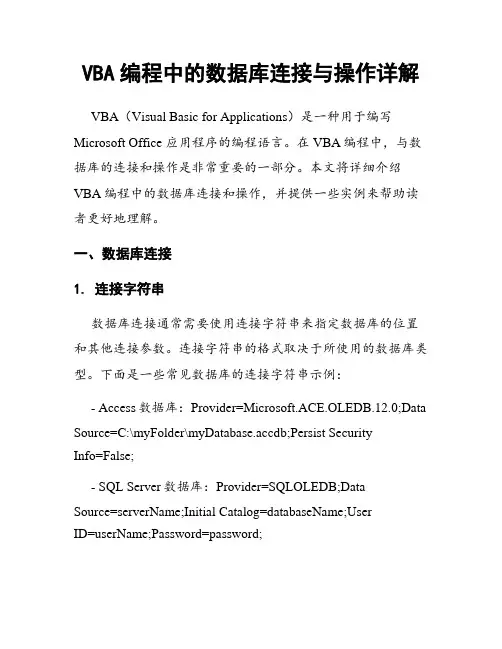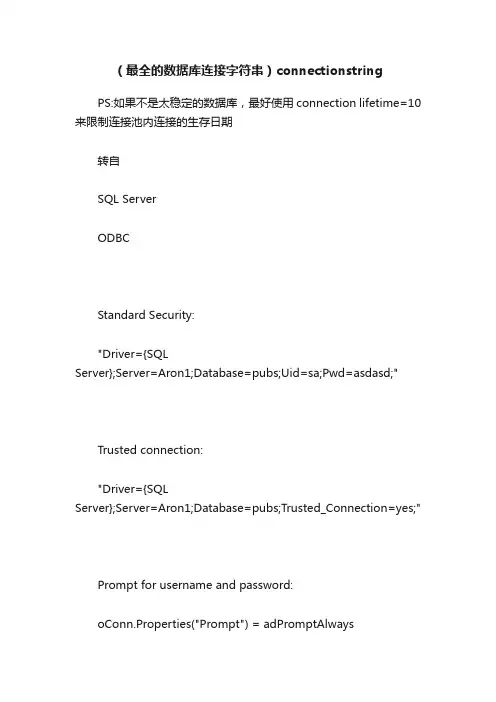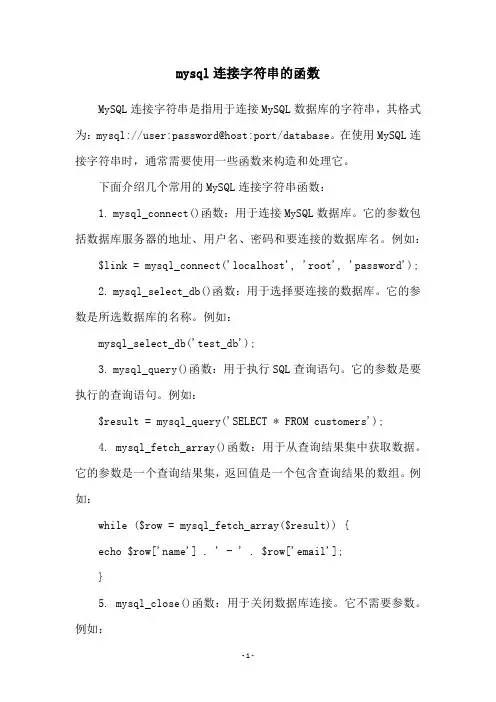数据库连接字符串
- 格式:docx
- 大小:12.99 KB
- 文档页数:5

VBA编程中的数据库连接与操作详解VBA(Visual Basic for Applications)是一种用于编写Microsoft Office 应用程序的编程语言。
在VBA编程中,与数据库的连接和操作是非常重要的一部分。
本文将详细介绍VBA编程中的数据库连接和操作,并提供一些实例来帮助读者更好地理解。
一、数据库连接1. 连接字符串数据库连接通常需要使用连接字符串来指定数据库的位置和其他连接参数。
连接字符串的格式取决于所使用的数据库类型。
下面是一些常见数据库的连接字符串示例:- Access数据库:Provider=Microsoft.ACE.OLEDB.12.0;Data Source=C:\myFolder\myDatabase.accdb;Persist SecurityInfo=False;- SQL Server数据库:Provider=SQLOLEDB;DataSource=serverName;Initial Catalog=databaseName;UserID=userName;Password=password;- MySQL数据库:Driver={MySQL ODBC 5.3Driver};Server=serverAddress;Database=databaseName;User=user ;Password=password;Option=3;需要注意,以上示例中的连接字符串仅供参考,实际使用时应根据具体情况进行修改。
2. 打开连接在VBA中,可以使用ADODB(ActiveX Data Objects)对象来进行数据库操作。
首先需要创建一个ADODB.Connection 对象,并使用连接字符串来打开连接。
下面是一个示例:```vbaDim conn As ObjectSet conn = CreateObject("ADODB.Connection")conn.ConnectionString ="Provider=Microsoft.ACE.OLEDB.12.0;DataSource=C:\myFolder\myDatabase.accdb;Persist SecurityInfo=False;"conn.Open```在打开连接之前,可以根据需要设置连接对象的其他属性,如CommandTimeout(执行命令的超时时间)和CursorLocation(指定游标的位置)等。

一、介绍SQLite数据库SQLite是一种轻量级的关系型数据库管理系统,它包含在一个相对小的C库中。
SQLite主要用途是在嵌入式设备上使用,例如移动通联方式、PDA、MP3播放器以及其他一些类型的嵌入式系统。
它可以使用SQL语言进行数据操作,包括创建表、查找数据、更新数据和删除数据等。
二、SQLite连接字符串在使用SQLite数据库时,连接字符串是非常重要的。
连接字符串是用来连接数据库服务器并指定要连接的数据库的一种字符串。
SQLite连接字符串有两种类型:绝对路径和相对路径。
本文将重点探讨SQLite 连接字符串的相对路径。
1. 相对路径的概念相对路径是指文件或目录相对于当前工作目录的路径。
在SQLite连接字符串中,相对路径表示数据库文件相对于应用程序的路径。
相对路径的好处是方便移植应用程序,只需将数据库文件与应用程序放在同一目录下即可。
2. 相对路径的使用在SQLite连接字符串中,使用相对路径需要注意以下几点:a. 相对路径的表示方式相对路径可以使用"."表示当前目录,".."表示上一级目录,以及其他相对位置的路径表示方式。
"./data.db"表示当前目录下的data.db文件,"../data/data.db"表示上一级目录下的data文件夹中的data.db文件。
b. 应用程序的当前工作目录应用程序的当前工作目录是指应用程序在执行时所处的目录。
在使用相对路径时,需要确保应用程序的当前工作目录与数据库文件所在的目录一致,否则连接会失败。
c. 设置当前工作目录可以使用操作系统提供的函数或方法来设置应用程序的当前工作目录,以确保正确使用相对路径。
在C#中可以使用Environment.CurrentDirectory属性来设置当前工作目录,在Java中可以使用System.setProperty("user.dir", "path")来设置当前工作目录。

数据库连接池的连接字符串写法在 中,连接字符串是用来建立与数据库之间的连接的关键元素。
连接字符串的写法取决于你使用的数据库类型和数据库引擎。
以下是一个示例连接字符串,用于连接到Microsoft SQL Server 数据库的连接池:```Imports System.Data.SqlClientModule Module1Sub Main()Dim connectionString As String = "Data Source=YourServerName;Initial Catalog=YourDatabaseName;User ID=YourUsername;Password=YourPassword;Integrated Security=False;Max Pool Size=100;Pooling=True;"Dim connection As New SqlConnection(connectionString)Tryconnection.Open()' 连接已经打开,可以执行数据库操作Console.WriteLine("Connected to SQL Server")Catch ex As ExceptionConsole.WriteLine("Error: " & ex.Message)Finallyconnection.Close()End TryEnd SubEnd Module```在这个示例中,你需要替换`YourServerName`、`YourDatabaseName`、`YourUsername` 和`YourPassword` 分别为你的SQL Server 的实际信息。
`Max Pool Size` 和`Pooling` 是用于配置连接池的选项,它们指定了连接池的最大大小和是否启用连接池。

MySQL中的连接字符串和连接选项配置在数据库应用程序中,连接到数据库是一个重要的步骤,连接字符串和连接选项配置是实现这一步骤的关键。
MySQL作为一种流行的关系型数据库管理系统(RDBMS),提供了丰富的连接字符串和连接选项配置功能,使得开发人员能够更好地控制和管理数据库连接。
连接字符串是用于指定数据库连接的字符串参数,包括数据库的地址、端口号、用户名、密码等信息。
连接选项配置是一组用于优化和调整数据库连接行为的参数,包括连接池大小、读写超时时间、字符编码等设置。
本文将详细介绍MySQL中连接字符串和连接选项配置的相关知识,希望能够帮助读者更好地理解和应用。
一、连接字符串连接字符串是用于指定数据库连接的字符串参数,它可以根据实际需求来设置不同的参数,以满足不同的数据库连接使用场景。
常见的连接字符串包括以下几个部分:1. 数据库地址数据库地址是指数据库服务器的地址和端口号,格式为"host:port"。
例如,localhost:3306表示连接到本地MySQL服务器的默认端口。
2. 用户名和密码用户名和密码是用于数据库身份验证的凭据,格式为"username:password"。
例如,root:123456表示使用用户名root和密码123456进行身份验证。
3. 数据库名称数据库名称是指要连接的数据库的名称,格式为"dbname"。
例如,mydatabase表示连接到名为mydatabase的数据库。
4. 字符编码字符编码是指数据库中存储的字符数据的编码格式,常用的编码格式包括UTF-8、GBK等。
可以通过设置字符编码来确保数据的正确存储和读取。
5. 其他可选参数除了上述基本参数外,连接字符串还可以包含其他可选参数,用于进一步优化和调整数据库连接行为。
例如,可以设置连接超时时间、读写超时时间、连接池大小等参数。
二、连接选项配置连接选项配置是一组用于优化和调整数据库连接行为的参数,可以通过连接字符串的方式进行配置。

C#数据库连接字符串⽂章转载⾄:sa登陆:"Data Source=.;Initial Catalog=数据库;User ID=sa,pwd=;";windows登陆Data Source=.;Initial Catalog=数据库;Integrated Security=Truec#数据库连接字符串集合(⼀)常⽤连接:1.使⽤SqlConnection对象:a. Sql 验证public void SqlConnectionOpen(){SqlConnection conn= new SqlConnection();conn.ConnectionString = "user id=sa;password=;initial catalog=northwind;datasource=localhost;connect Timeout=20";conn.Open();}b. Windows ⾝份验证public void SqlConnectionOpen(){SqlConnection conn= new SqlConnection();conn.ConnectionString = "Integrated Security=SSPI;initial catalog=northwind;datasource=localhost;connect Timeout=20";conn.Open();}2.使⽤OleDbConnection对象:public void OleDBConnectionOpen(){OleDBConnection conn = new OleDbconnection();conn.ConnectionString="Provider=Microsoft.Jet.OLEDB.4.0;DataSource=C:\Customer.mdb";conn.Open();}(⼆)其它:1.ODBC连接Access本地数据库conGoodDay.Open("Driver={Microsoft Access Driver(*.mdb)};"+"Dbq=C:\a.mdb;"+"Uid=Admin;"+"Pwd=;");2.ODBC连接Access系统数据库conGoodDay.Open("Driver={Microsoft Access Driver(*.mdb)};"+"Dbq=C:\a.mdb;"+"SystemDB=Admin;"+"Pwd=;");3.ODBC连接Access系统数据库conGoodDay.Open("Driver={Microsoft Access Driver(*.mdb)};"+"Dbq=\\server\share\a.mdb;");4.ODBC连接Excel系统数据库conGoodDay.Open("Driver={Microsoft Access Driver(*.xls)};"+"DriverId=790;"+"Dbq=C:\a.xls;"+"DefaultDir=c:\somepath;");5.ODBC连接Oracle系统数据库conGoodDay.Open("Driver={Microsoft ODBC for oracle};"+"Server=OracleServer.world;"+"Uid=Admin;"+"Pwd=password;");6.ODBC连接Sql ServrconGoodDay.Open("Driver={Sql Server};"+"Server=myServer;"+"Database=myDatabaseName;""Uid=Admin;"+"Pwd=password;");7.ODBC连接Visual FoxProconGoodDay.Open("Driver={Microsoft Visual FoxPro Driver};"+"SourceType=DBC;"+"SourceDB=c:a.dbc;"+"Exclusive=No;");Windows ⾝份验证建议使⽤ Windows ⾝份验证(有时也称为“集成安全性”)连接到⽀持其的数据源。

(最全的数据库连接字符串)connectionstringPS:如果不是太稳定的数据库,最好使用connection lifetime=10来限制连接池内连接的生存日期转自SQL ServerODBCStandard Security:"Driver={SQLServer};Server=Aron1;Database=pubs;Uid=sa;Pwd=asdasd;"Trusted connection:"Driver={SQLServer};Server=Aron1;Database=pubs;Trusted_Connection=yes;"Prompt for username and password:oConn.Properties("Prompt") = adPromptAlwaysoConn.Open "Driver={SQL Server};Server=Aron1;DataBase=pubs;"OLE DB, OleDbConnection (.NET)Standard Security:"Provider=sqloledb;Data Source=Aron1;Initial Catalog=pubs;User Id=sa;Password=asdasd;"Trusted Connection:"Provider=sqloledb;Data Source=Aron1;Initial Catalog=pubs;Integrated Security=SSPI;"(use serverName\instanceName as Data Source to use an specifik SQLServer instance, only SQLServer2000)Prompt for username and password:oConn.Provider = "sqloledb"oConn.Properties("Prompt") = adPromptAlwaysoConn.Open "Data Source=Aron1;Initial Catalog=pubs;"Connect via an IP address:"Provider=sqloledb;DataSource=190.190.200.100,1433;NetworkLibrary=DBMSSOCN;Initial Catalog=pubs;User ID=sa;Password=asdasd;"(DBMSSOCN=TCP/IP instead of Named Pipes, at the end of the Data Source is the port to use (1433 is the default))SqlConnection (.NET)Standard Security:"Data Source=Aron1;Initial Catalog=pubs;User Id=sa;Password=asdasd;"- or -"Server=Aron1;Database=pubs;UserID=sa;Password=asdasd;Trusted_Connection=False"(both connection strings produces the same result)Trusted Connection:"Data Source=Aron1;Initial Catalog=pubs;Integrated Security=SSPI;"- or -"Server=Aron1;Database=pubs;Trusted_Connection=True;"(both connection strings produces the same result)(use serverName\instanceName as Data Source to use an specifik SQLServer instance, only SQLServer2000)Connect via an IP address:"Data Source=190.190.200.100,1433;Network Library=DBMSSOCN;Initial Catalog=pubs;User ID=sa;Password=asdasd;"(DBMSSOCN=TCP/IP instead of Named Pipes, at the end of the Data Source is the port to use (1433 is the default))Declare the SqlConnection:C#:using System.Data.SqlClient;SqlConnection oSQLConn = new SqlConnection(); oSQLConn.ConnectionString="my connection string"; oSQLConn.Open();:Imports System.Data.SqlClientDim oSQLConn As SqlConnection = New SqlConnection() oSQLConn.ConnectionString="my connection string" oSQLConn.Open()Data ShapeMS Data Shape"Provider=MSDataShape;Data Provider=SQLOLEDB;Data Source=Aron1;Initial Catalog=pubs;User ID=sa;Password=asdasd;"Want to learn data shaping? Check out 4GuyfFromRolla's great article about Data Shaping >>Read moreHow to define which network protocol to useExample:"Provider=sqloledb;DataSource=190.190.200.100,1433;NetworkLibrary=DBMSSOCN;Initial Catalog=pubs;User ID=sa;Password=asdasd;"Name Network librarydbnmpntw Win32 Named Pipesdbmssocn Win32 Winsock TCP/IPdbmsspxn Win32 SPX/IPXdbmsvinn Win32 Banyan Vinesdbmsrpcn Win32 Multi-Protocol (Windows RPC)Important note!When connecting through the SQLOLEDB provider use the syntax Network Library=dbmssocnand when connecting through MSDASQL provider use the syntax Network=dbmssocnAll SqlConnection connection string propertiesThis table shows all connection string properties for the SqlConnection object. Most of the properties are also used in ADO. All properties and descriptions is from msdn.Name Default DescriptionApplication Name The name of the application, or '.Net SqlClient Data Provider' if no application name is provided.AttachDBFilename-or-extended properties-or-Initial File Name The name of the primary file, including the full path name, of an attachable database. The database name must be specified with the keyword 'database'.Connect Timeout-or-Connection Timeout 15 The length of time (in seconds) to wait for a connection to the server before terminating the attempt and generating an error.Connection Lifetime 0 When a connection is returned to the pool, its creation time is compared with the current time, and the connection is destroyed if that time span (in seconds) exceeds the value specified by connection lifetime. Useful in clustered configurations to force load balancing between a running server and a server just brought on-line.Connection Reset 'true' Determines whether the database connection is reset when being removed from the pool. Setting to 'false' avoids making an additional server round-trip when obtaining a connection, but the programmer must be aware thatthe connection state is not being reset.Current Language The SQL Server Language record name.Data Source-or-Server-or-Address-or-Addr-or-Network Address The name or network address of the instance of SQL Server to which to connect.Enlist 'true' When true, the pooler automatically enlists the connection in the creation thread's current transaction context.Initial Catalog-or-Database The name of the database.Integrated Security-or-Trusted_Connection 'false' Whether the connection is to be a secure connection or not. Recognized values are 'true', 'false', and 'sspi', which is equivalent to 'true'.Max Pool Size 100 The maximum number of connections allowed in the pool.Min Pool Size 0 The minimum number of connections allowed in the pool.Network Library-or-Net 'dbmssocn' The network library used to establish a connection to an instance of SQL Server. Supported values include dbnmpntw (Named Pipes), dbmsrpcn (Multiprotocol), dbmsadsn (Apple Talk), dbmsgnet (VIA), dbmsipcn (Shared Memory) and dbmsspxn (IPX/SPX), and dbmssocn (TCP/IP).The corresponding network DLL must be installed on the system to which you connect. If you do not specify a network and you use a local server (for example, "." or "(local)"), shared memory is used.Packet Size 8192 Size in bytes of the network packets used to communicate with an instance of SQL Server.Password-or-Pwd The password for the SQL Server account logging on.Persist Security Info 'false' When set to 'false', security-sensitive information, such as the password, is not returned as part of the connection if the connection is open or has ever been in an open state. Resetting the connection string resets all connection string values including the password.Pooling 'true' When true, the SQLConnection object is drawn from the appropriate pool, or if necessary, is created and added to the appropriate pool.User ID The SQL Server login account.Workstation ID the local computer name The name of the workstation connecting to SQL Server.NoteUse ; to separate each property.If a name occurs more than once, the value from the last one in the connection string will be used.If you are building your connection string in your app using values from user input fields, make sure the user can't change the connection string by inserting an additional property with another value within the user value.SQL Server 2005SQL Native Client ODBC DriverStandard security:"Driver={SQL Native Client};Server=Aron1;Database=pubs;UID=sa;PWD=asdasd;"Trusted connection:"Driver={SQL Native Client};Server=Aron1;Database=pubs;Trusted_Connection=yes;"EquivalentsIntegrated Security=SSPI equals Trusted_Connection=yesPrompt for username and password:oConn.Properties("Prompt") = adPromptAlwaysoConn.Open "Driver={SQL Native Client};Server=Aron1;DataBase=pubs;"Enabling MARS (multiple active result sets):"Driver={SQL Native Client};Server=Aron1;Database=pubs;Trusted_Connection=yes; MARS_Connection=yes"EquivalentsMultipleActiveResultSets=true equals MARS_Connection=yesUsing MARS with SQL Native Client, by Chris Lee >>Encrypt data sent over network:"Driver={SQL Native Client};Server=Aron1;Database=pubs;Trusted_Connection=yes;E ncrypt=yes"Attach a database file on connect to a local SQL Server Express instance:"Driver={SQL Native Client};Server=.\SQLExpress;AttachDbFilename=c:\asd\qwe\myd bfile.mdf;Database=dbname;Trusted_Connection=Yes;"- or -"Driver={SQL Native Client};Server=.\SQLExpress;AttachDbFilename=|DataDirectory| mydbfile.mdf;Database=dbname;Trusted_Connection=Yes;"(use |DataDirectory| when your database file resides in the data directory)Why is the "Database" parameter needed? Answer: If the database was previously attached, SQL Server does not reattach it (it uses the attached database as the default for the connection).Download the SQL Native Client here >> (the package contains booth the ODBC driver and the OLE DB provider)Using SQL Server 2005 Express? Don't miss the server name syntax: SERVERNAME\SQLEXPRESS (Substitute "SERVERNAME" with the name of the computer)SQL Native Client OLE DB ProviderStandard security:"Provider=SQLNCLI;Server=Aron1;Database=pubs;UID=sa;P WD=asdasd;"Trusted connection:"Provider=SQLNCLI;Server=Aron1;Database=pubs;Trusted_ Connection=yes;"EquivalentsIntegrated Security=SSPI equals Trusted_Connection=yesPrompt for username and password:oConn.Properties("Prompt") = adPromptAlwaysoConn.Open"Provider=SQLNCLI;Server=Aron1;DataBase=pubs;"Enabling MARS (multiple active result sets):"Provider=SQLNCLI;Server=Aron1;Database=pubs;Trusted_Connection=yes;MarsConn=yes"EquivalentsMarsConn=yes equals MultipleActiveResultSets=true equals MARS_Connection=yesUsing MARS with SQL Native Client, by Chris Lee >>Encrypt data sent over network:"Provider=SQLNCLI;Server=Aron1;Database=pubs;Trusted_ Connection=yes;Encrypt=yes"Attach a database file on connect to a local SQL Server Express instance:"Provider=SQLNCLI;Server=.\SQLExpress;AttachDbFilename =c:\asd\qwe\mydbfile.mdf;Database=dbname;Trusted_Connecti on=Yes;"- or -"Provider=SQLNCLI;Server=.\SQLExpress;AttachDbFilename =|DataDirectory|mydbfile.mdf;Database=dbname;Trusted_Conn ection=Yes;"(use |DataDirectory| when your database file resides in thedata directory)Why is the "Database" parameter needed? Answer: If the database was previously attached, SQL Server does not reattach it (it uses the attached database as the default for the connection).Download the SQL Native Client here >> (the package contains booth the ODBC driver and the OLE DB provider)Using SQL Server 2005 Express? Don't miss the server name syntax: SERVERNAME\SQLEXPRESS (Substitute "SERVERNAME" with the name of the computer)SqlConnection (.NET)Standard Security:"Data Source=Aron1;Initial Catalog=pubs;User Id=sa;Password=asdasd;"- or -"Server=Aron1;Database=pubs;UserID=sa;Password=asdasd;Trusted_Connection=False"(both connection strings produces the same result)Trusted Connection:"Data Source=Aron1;Initial Catalog=pubs;Integrated Security=SSPI;"- or -"Server=Aron1;Database=pubs;Trusted_Connection=True;"(both connection strings produces the same result)(use serverName\instanceName as Data Source to use an specifik SQLServer instance)Connect via an IP address:"Data Source=190.190.200.100,1433;Network Library=DBMSSOCN;Initial Catalog=pubs;User ID=sa;Password=asdasd;"(DBMSSOCN=TCP/IP instead of Named Pipes, at the end of the Data Source is the port to use (1433 is the default))Enabling MARS (multiple active result sets):"Server=Aron1;Database=pubs;Trusted_Connection=True;M ultipleActiveResultSets=true"Note! Use 2.0 for MARS functionality. MARS is not supported in 1.0 nor 1.1Streamline your Data Connections by Moving to MARS, by Laurence Moroney, >>Attach a database file on connect to a local SQL Server Express instance:"Server=.\SQLExpress;AttachDbFilename=c:\asd\qwe\mydb file.mdf;Database=dbname;Database=dbname;Trusted_Connect ion=Yes;"- or -"Server=.\SQLExpress;AttachDbFilename=|DataDirectory|m ydbfile.mdf;Database=dbname;Trusted_Connection=Yes;"(use |DataDirectory| when your database file resides in the data directory)Why is the "Database" parameter needed? Answer: If the database was previously attached, SQL Server does not reattach it (it uses the attached database as the default for the connection).Using "User Instance" on a local SQL Server Express instance:"Data Source=.\SQLExpress;integrated security=true;attachdbfilename=|DataDirectory|\mydb.mdf;user instance=true;"The "User Instance" functionality creates a new SQL Server instance on the fly during connect. This works only on a local SQL Server 2005 instance and only when connecting using windows authentication over local named pipes. The purpose is to be able to create a full rights SQL Server instance to a user with limited administrative rights on the computer. To enable the functionality: sp_configure 'user instances enabled','1' (0 to disable)Using SQL Server 2005 Express? Don't miss the server name syntax: SERVERNAME\SQLEXPRESS (Substitute "SERVERNAME" with the name of the computer)Context Connection - connecting to "self" from within your CLR stored prodedure/functionC#:using(SqlConnection connection = new SqlConnection("context connection=true")){connection.Open();// Use the connection}Visual Basic:Using connection as new SqlConnection("context connection=true")connection.Open()' Use the connectionEnd UsingThe context connection lets you execute Transact-SQL statements in the same context (connection) that your code was invoked in the first place.Read moreWhen to use SQL Native Client?.Net applicationsDo not use the SQL Native Client. Use the .NET Framework Data Provider for SQL Server (SqlConnection).COM applications, all other then .NET applicationsUse the SQL Native Client if you are accessing an SQL Server 2005 and need the new features of SQL Server 2005 such as MARS, encryption, XML data type etc. Continue use your current provider (OLE DB / ODBC through the MDAC package) if you are not connecting to an SQL Server 2005 (that's quite obvious eh..) or if you are connecting to an SQL Server 2005 but are not using any of the new SQL Server 2005 features.For more details on the differences between MDAC and SQL Native Client, read this msdn article >>AccessODBCStandard Security:"Driver={Microsoft Access Driver (*.mdb)};Dbq=C:\mydatabase.mdb;Uid=Admin;Pwd=;"Workgroup:"Driver={Microsoft Access Driver (*.mdb)};Dbq=C:\mydatabase.mdb;SystemDB=C:\mydatabase.m dw;"Exclusive:"Driver={Microsoft Access Driver (*.mdb)};Dbq=C:\mydatabase.mdb;Exclusive=1;Uid=admin;Pwd ="OLE DB, OleDbConnection (.NET)Standard security:"Provider=Microsoft.Jet.OLEDB.4.0;DataSource=\somepath\mydb.mdb;User Id=admin;Password=;"Workgroup (system database):"Provider=Microsoft.Jet.OLEDB.4.0;DataSource=\somepath\mydb.mdb;Jet OLEDB:System Database=system.mdw;"With password:"Provider=Microsoft.Jet.OLEDB.4.0;DataSource=\somepath\mydb.mdb;Jet OLEDB:Database Password=MyDbPassword;"OracleODBCNew version:"Driver={Microsoft ODBC for Oracle};Server=OracleServer.world;Uid=Username;Pwd=asdasd; "Old version:"Driver={Microsoft ODBC Driver for Oracle};ConnectString=OracleServer.world;Uid=myUsername;Pw d=myPassword;"OLE DB, OleDbConnection (.NET)Standard security:"Provider=msdaora;Data Source=MyOracleDB;User Id=UserName;Password=asdasd;"This one's from Microsoft, the following are from OracleStandard Security:"Provider=OraOLEDB.Oracle;Data Source=MyOracleDB;User Id=Username;Password=asdasd;"Trusted Connection:"Provider=OraOLEDB.Oracle;DataSource=MyOracleDB;OSAuthent=1;"OracleConnection (.NET)Standard:"Data Source=MyOracleDB;Integrated Security=yes;"This one works only with Oracle 8i release 3 or laterSpecifying username and password:"Data Source=MyOracleDB;User Id=username;Password=passwd;Integrated Security=no;"This one works only with Oracle 8i release 3 or laterDeclare the OracleConnection:C#:using System.Data.OracleClient;OracleConnection oOracleConn = new OracleConnection();oOracleConn.ConnectionString = "my connection string";oOracleConn.Open();:Imports System.Data.OracleClientDim oOracleConn As OracleConnection = New OracleConnection()oOracleConn.ConnectionString = "my connection string"oOracleConn.Open()Missing the System.Data.OracleClient namespace? Download .NET Managed Provider for Oracle >>Great article! "Features of Oracle Data Provider for .NET" by Rama Mohan G. at C# CornerCore Labs OraDirect (.NET)Standard:"User ID=scott; Password=tiger; Host=ora; Pooling=true; Min Pool Size=0;Max Pool Size=100; Connection Lifetime=0"Read more at Core Lab and the product page.Data ShapeMS Data Shape:"Provider=MSDataShape.1;Persist Security Info=False;Data Provider=MSDAORA;Data Source=orac;user id=username;password=mypw"Want to learn data shaping? Check out 4GuyfFromRolla's great article about Data Shaping >>MySQLMyODBCMyODBC 2.50 Local database:"Driver={mySQL};Server=localhost;Option=16834;Database =mydatabase;"MyODBC 2.50 Remote database:"Driver={mySQL};Server=;Port=3306;Optio n=131072;Stmt=;Database=my-database;Uid=username;Pwd=password;"MyODBC 3.51 Local database:"DRIVER={MySQL ODBC 3.51 Driver};SERVER=localhost;DATABASE=myDatabase;USER=myUs ername;PASSWORD=myPassword;OPTION=3;"MyODBC 3.51 Remote database:"DRIVER={MySQL ODBC 3.51 Driver};SERVER=;PORT=3306;DATABASE=myD atabase;USER=myUsername;PASSWORD=myPassword;OPTION=3;"OLE DB, OleDbConnection (.NET)Standard:"Provider=MySQLProv;Data Source=mydb;User Id=UserName;Password=asdasd;"Connector/Net 1.0 (.NET)Standard:"Server=Server;Database=Test;Uid=UserName;Pwd=asdasd ;"Download the driver at MySQL Developer Zone.Specifying port:"Server=Server;Port=1234;Database=Test;Uid=UserName;P wd=asdasd;"Default port is 3306. Enter value -1 to use a named pipe connection.Declare the MySqlClient connection:C#:using MySql.Data.MySqlClient;MySqlConnection oMySqlConn = new MySqlConnection();oMySqlConn.ConnectionString = "Server=Server;Database=Test;Uid=UserName;Pwd=asdasd;";oMySqlConn.Open();:Imports MySql.Data.MySqlClientDim oMySqlConn As MySqlConnection = New MySqlConnection()oMySqlConn.ConnectionString = "Server=Server;Database=Test;Uid=UserName;Pwd=asdasd;"oMySqlConn.Open()MySqlConnection (.NET)eInfoDesigns.dbProvider:"Data Source=server;Database=mydb;User ID=username;Password=pwd;Command Logging=false"This one is used with eInfoDesigns dbProvider, an add-on to .NETDeclare the MySqlConnection:C#:using eInfoDesigns.dbProvider.MySqlClient;MySqlConnection oMySqlConn = new MySqlConnection();oMySqlConn.ConnectionString = "my connection string";oMySqlConn.Open();:Imports eInfoDesigns.dbProvider.MySqlClientDim oMySqlConn As MySqlConnection = New MySqlConnection()oMySqlConn.ConnectionString = "my connection string"oMySqlConn.Open()SevenObjects MySqlClient (.NET)Standard:"Host=server; UserName=myusername; Password=mypassword;Database=mydb;"This is a freeware data provider from SevenObjectsCore Labs MySQLDirect (.NET)Standard:"User ID=root; Password=pwd; Host=localhost; Port=3306; Database=test;Direct=true; Protocol=TCP; Compress=false; Pooling=true; Min Pool Size=0;Max Pool Size=100; Connection Lifetime=0"Read more at Core Lab and the product page.InterbaseODBC, EasysoftLocal computer:"Driver={Easysoft IB6 ODBC};Server=localhost;Database=localhost:C:\mydatabase.gd b;Uid=username;Pwd=password"Remote Computer:"Driver={Easysoft IB6 ODBC};Server=ComputerName;Database=ComputerName:C:\m ydatabase.gdb;Uid=username;Pwd=password"Read more about this driver: Easysoft ODBC-Interbase driver >>ODBC, IntersolvLocal computer:"Driver={INTERSOLV InterBase ODBC Driver (*.gdb)};Server=localhost;Database=localhost:C:\mydatabase.gd b;Uid=username;Pwd=password"Remote Computer:"Driver={INTERSOLV InterBase ODBC Driver (*.gdb)};Server=ComputerName;Database=ComputerName:C:\ mydatabase.gdb;Uid=username;Pwd=password"This driver are provided by DataDirect Technologies >> (formerly Intersolv)OLE DB, SIBPROviderStandard:"provider=sibprovider;location=localhost:;datasource=c:\databases\gdbs\mygdb.gdb;userid=SYSDBA;password=masterkey"Specifying character set:"provider=sibprovider;location=localhost:;datasource=c:\databases\gdbs\mygdb.gdb;userid=SYSDBA;password=masterkey;character set=ISO8859_1"Specifying role:"provider=sibprovider;location=localhost:;datasource=c:\databases\gdbs\mygdb.gdb;userid=SYSDBA;password=masterkey;role=DIGITADORES"Read more about SIBPROvider >>Read more about connecting to Interbase in this Borland Developer Network articleIBM DB2OLE DB, OleDbConnection (.NET) from msTCP/IP:"Provider=DB2OLEDB;Network TransportLibrary=TCPIP;Network Address=XXX.XXX.XXX.XXX;Initial Catalog=MyCtlg;Package Collection=MyPkgCol;Default Schema=Schema;User ID=MyUser;Password=MyPW"APPC:"Provider=DB2OLEDB;APPC Local LU Alias=MyAlias;APPC Remote LU Alias=MyRemote;Initial Catalog=MyCtlg;Package Collection=MyPkgCol;Default Schema=Schema;User ID=MyUser;Password=MyPW"IBM's OLE DB Provider (shipped with IBM DB2 UDB v7 or above)TCP/IP:Provider=IBMDADB2;Database=sample;HOSTNAME=db2h ost;PROTOCOL=TCPIP;PORT=50000;uid=myUserName;pwd=my Pwd;ODBCStandard:"driver={IBM DB2 ODBC DRIVER};Database=myDbName;hostname=myServerName;port =myPortNum;protocol=TCPIP; uid=myUserName; pwd=myPwd"SybaseODBCStandard Sybase System 12 (or 12.5) Enterprise Open Client:"Driver={SYBASE ASE ODBC Driver};Srvr=Aron1;Uid=username;Pwd=password"Standard Sybase System 11:"Driver={SYBASE SYSTEM 11};Srvr=Aron1;Uid=username;Pwd=password;Database=mydb "For more information check out the Adaptive ServerEnterprise Document SetsIntersolv 3.10:"Driver={INTERSOLV 3.10 32-BIT Sybase};Srvr=Aron1;Uid=username;Pwd=password;"Sybase SQL Anywhere (former Watcom SQL ODBC driver):"ODBC; Driver=Sybase SQL Anywhere 5.0; DefaultDir=c:\dbfolder\;Dbf=c:\mydatabase.db;Uid=username;P wd=password;Dsn="""""Note! The two double quota following the DSN parameter at the end are escaped quotas (VB syntax), you may have to change this to your language specific escape syntax. The empty DSN parameter is indeed critical as not including it will result in error 7778.Read more in the Sybase SQL Anywhere User Guide (see part 3, chapter 13) >>OLE DBAdaptive Server Anywhere (ASA):"Provider=ASAProv;Data source=myASA"Read more in the ASA User Guide (part 1, chapter 2) >>Adaptive Server Enterprise (ASE) with Data Source .IDS file:"Provider=Sybase ASE OLE DB Provider; Data source=myASE"Note that you must create a Data Source .IDS file using the Sybase Data Administrator. These .IDS files resemble ODBC DSNs.Adaptive Server Enterprise (ASE):"Provider=Sybase.ASEOLEDBProvider;Srvr=myASEserver,50 00;Catalog=myDBname;UserId=username;Password=password"- some reports on problem using the above one, try the following as an alternative -"Provider=Sybase.ASEOLEDBProvider;ServerName=myASEserver,5000;Initial Catalog=myDBname;User Id=username;Password=password"This one works only from Open Client 12.5 where the server port number feature works,燼llowing fully qualified connection strings to be used without defining燼ny .IDS Data Source files.AseConnection (.NET)Standard:"DataSource='myASEserver';Port=5000;Database='myDBname';UID=' username';PWD='password';"Declare the AseConnection:C#:using Sybase.Data.AseClient;AseConnection oCon = new AseConnection();oCon.ConnectionString="my connection string";oCon.Open();:Imports System.Data.AseClientDim oCon As AseConnection = New AseConnection()oCon.ConnectionString="my connection string"oCon.Open()Read more! Adaptive Server Enterprise Data Provider Documentation >>InformixODBCInformix 3.30:"Dsn='';Driver={INFORMIX 3.30 32 BIT};Host=hostname;Server=myserver;Service=service-name;Protocol=olsoctcp;Database=mydb;UID=username;PWD= myPwdInformix-CLI 2.5:"Driver={Informix-CLI 2.5 (32Bit)};Server=myserver;Database=mydb;Uid=username;Pwd=my Pwd"OLE DBIBM Informix OLE DB Provider:"Provider=Ifxoledbc.2;password=myPw;UserID=myUser;Data Source=dbName@serverName;Persist Security Info=true"IngresODBCDSN-less"Provider=MSDASQL.1;DRIVER=Ingres;SRVR=xxxxx;DB=xxx xx;Persist Security Info=False;uid=xxxx;pwd=xxxxx;SELECTLOOPS=N;Extended Properties="""SERVER=xxxxx;DATABASE=xxxxx;SERVERTYPE=IN GRES""Mimer SQLODBCStandard Security:"Driver={MIMER};Database=mydb;Uid=myuser;Pwd=mypw; "Prompt for username and password:"Driver={MIMER};Database=mydb;"LightbaseStandardStandard:"user=USERLOGIN;password=PASSWORD;UDB=USERBASE; server=SERVERNAME"PostgreSQLCore Labs PostgreSQLDirect (.NET)Standard:"User ID=root; Password=pwd; Host=localhost; Port=5432; Database=testdb;Pooling=true; Min Pool Size=0; Max Pool Size=100; Connection Lifetime=0"Read more at Core Lab and the product page.PostgreSQL driverStandard:"DRIVER={PostgreSQL};SERVER=ipaddress;port=5432;DATA BASE=dbname;UID=username;PWD=password;"Npgsql by pgFoundry (.NET)SSL activated:"Server=127.0.0.1;Port=5432;Userid=myuserid;password=m ypw;Protocol=3;SSL=true;Pooling=true;MinPoolSize=3;MaxPool Size=20;Encoding=UNICODE;Timeout=20;SslMode=Require"Without SSL:"Server=127.0.0.1;Port=5432;Userid=myuserid;password=m ypw;Protocol=3;SSL=false;Pooling=true;MinPoolSize=1;MaxPoo lSize=20;Encoding=UNICODE;Timeout=15;SslMode=Disable"Read more in the Npgsql: User's Manual and on the pgFoundry website.ParadoxODBC5.X:Driver={Microsoft Paradox Driver (*.db )};DriverID=538;Fil=Paradox 5.X;DefaultDir=c:\pathToDb\;Dbq=c:\pathToDb\;CollatingSeque nce=ASCII"7.X:"Provider=MSDASQL.1;Persist Security Info=False;Mode=Read;ExtendedProperties='DSN=Paradox;DBQ=C:\myDb;DefaultDir=C:\myDb; DriverId=538;FIL=Paradox7.X;MaxBufferSize=2048;PageTimeout=600;';InitialCatalog=C:\myDb"OleDbConnection (.NET)Standard"Provider=Microsoft.Jet.OLEDB.4.0;DataSource=c:\myDb;Extended Properties=Paradox 5.x;"。

mysql连接字符串的函数MySQL连接字符串是指用于连接MySQL数据库的字符串,其格式为:mysql://user:password@host:port/database。
在使用MySQL连接字符串时,通常需要使用一些函数来构造和处理它。
下面介绍几个常用的MySQL连接字符串函数:1. mysql_connect()函数:用于连接MySQL数据库。
它的参数包括数据库服务器的地址、用户名、密码和要连接的数据库名。
例如: $link = mysql_connect('localhost', 'root', 'password');2. mysql_select_db()函数:用于选择要连接的数据库。
它的参数是所选数据库的名称。
例如:mysql_select_db('test_db');3. mysql_query()函数:用于执行SQL查询语句。
它的参数是要执行的查询语句。
例如:$result = mysql_query('SELECT * FROM customers');4. mysql_fetch_array()函数:用于从查询结果集中获取数据。
它的参数是一个查询结果集,返回值是一个包含查询结果的数组。
例如:while ($row = mysql_fetch_array($result)) {echo $row['name'] . ' - ' . $row['email'];}5. mysql_close()函数:用于关闭数据库连接。
它不需要参数。
例如:mysql_close();以上就是一些常用的MySQL连接字符串函数。
使用它们可以方便地构造和处理MySQL连接字符串,从而实现与MySQL数据库的连接和操作。

sqlite连接字符串的方法摘要:1.SQLite连接概述2.编写SQLite连接字符串的方法3.示例:使用Python和SQLite连接4.连接字符串的参数详解5.总结与建议正文:**一、SQLite连接概述**SQLite是一款轻量级的关系型数据库,它将数据存储在一个磁盘文件中,并提供了一套完整的SQL查询语言。
SQLite具有很多优点,如高性能、易于使用、跨平台等。
在实际项目中,我们可以通过编写连接字符串来连接SQLite 数据库。
**二、编写SQLite连接字符串的方法**要编写SQLite连接字符串,我们需要提供以下几个关键信息:1.数据库文件路径:可以是相对路径或绝对路径,例如:`file:///test.db`。
2.数据库加密方式:可选,默认不加密。
可以使用`sqlite3.加密`进行加密。
3.数据库版本:可选,默认为3.4.数据库别名:可选,用于区分相同路径下的不同数据库。
连接字符串的基本格式如下:```sqlite:///[数据库文件路径][?数据库加密方式][&数据库版本][@数据库别名]```**三、示例:使用Python和SQLite连接**以下是一个使用Python连接SQLite数据库的示例:```pythonimport sqlite3# 编写连接字符串conn_str ="sqlite:///test.db?password=mypassword&timeout=5000"# 连接数据库conn = sqlite3.connect(conn_str)# 操作数据库cursor = conn.cursor()cursor.execute("CREATE TABLE IF NOT EXISTS example (id INTEGER PRIMARY KEY, name TEXT)")cursor.execute("INSERT INTO example (name) VALUES ("John")") mit()# 查询数据cursor.execute("SELECT * FROM example")rows = cursor.fetchall()for row in rows:print(row)# 关闭连接conn.close()```**四、连接字符串参数详解**1.数据库文件路径:必需参数,表示数据库文件的路径。

JDBC数据库连接字符串及连接方法1、连接mysql第一步:从mysql-connector-java目录下面将mysql-connector的jar包导入到lomboz_eclipse中第二步:Class.forName("com.mysql.jdbc.Driver");Connection conn=DriverManager.getConnection("jdbc:mysql://localhost/mydata?"+"user=root&password=root"); 注:“?”前的“mydata”是具体的数据库名称,根据需要连接的具体数据库名称填入。
2、Oracle8/8i/9i数据库(thin模式)第一步:将Oracle提供的jar包导入到编程环境中(如lomboz_eclipse)。
第二步:Class.forName("oracle.jdbc.driver.OracleDriver").newInstance();Connection conn= DriverManager.getConnection(url, user, password);url="jdbc:oracle:thin:@localhost:1521:orcl"; //orcl为数据库的SIDuser="test";password="test";3、连接SQLServer2005Class.forName("com.microsoft.sqlserver.jdbc.SQLServerDriver");conn = DriverManager.getConnection("jdbc:sqlserver://localhost:1433;DatabaseName=mydata","sa","root"); stmt = conn.createStatement();rs = stmt.executeQuery("select * from users");while(rs.next()) {System.out.println(rs.getString(2));}4、连接access首先建立数据库和数据源lxhdb,当数据库没密码时:Class.forName("sun.jdbc.odbc.JdbcOdbcDriver");conn = DriverManager.getConnection("jdbc:odbc:lxhdb");如果有密码conn = DriverManager.getConnection("jdbc:odbc:数据源","用户名","密码");stmt = conn.createStatement();rs = stmt.executeQuery("select * from user");5、SQL Server7.0/2000数据库Class.forName("com.microsoft.jdbc.sqlserver.SQLServerDriver").newInstance();String url="jdbc:microsoft:sqlserver://localhost:1433;DatabaseName=mydb";//mydb为数据库String user="sa";String password="";Connection conn= DriverManager.getConnection(url,user,password);6、DB2数据库Class.forName("com.ibm.db2.jdbc.app.DB2Driver ").newInstance();String url="jdbc:db2://localhost:5000/sample"; //sample为你的数据库名String user="admin";String password="";Connection conn= DriverManager.getConnection(url,user,password);7、Sybase数据库Class.forName("com.sybase.jdbc.SybDriver").newInstance();String url =" jdbc:sybase:Tds:localhost:5007/myDB";//myDB为你的数据库名Properties sysProps = System.getProperties();SysProps.put("user","userid");SysProps.put("password","user_password");Connection conn= DriverManager.getConnection(url, SysProps);8、Informix数据库Class.forName("rmix.jdbc.IfxDriver").newInstance();String url = "jdbc:informix-sqli://123.45.67.89:1533/myDB:INFORMIXSERVER=myserver; user=testuser;password=testpassword"; //myDB为数据库名Connection conn= DriverManager.getConnection(url);9、PostgreSQL数据库Class.forName("org.postgresql.Driver").newInstance();String url ="jdbc:postgresql://localhost/myDB" //myDB为数据库名String user="myuser";String password="mypassword";Connection conn= DriverManager.getConnection(url,user,password);10、连接excel数据源(ODBC)点击添加,在弹出窗口中选择“Driver do Microsoft Excel(*.xls)”名为myxls Class.forName("sun.jdbc.odbc.JdbcOdbcDriver");conn = DriverManager.getConnection("jdbc:odbc:myxls");stmt = conn.createStatement();rs = stmt.executeQuery("select * from [Sheet1$]");。

数据库连接字符串配置的注意事项数据库连接字符串是在应用程序中配置和使用的重要参数,它决定了应用程序与数据库的连接方式和参数。
正确的连接字符串配置是保证数据库连接稳定和安全的关键因素之一。
本文将介绍一些配置数据库连接字符串时需要注意的事项。
1. 遵循安全原则数据库连接字符串中包含了敏感信息,如用户名、密码等。
为了保护这些信息,务必采取一些安全措施:- 不要将完整的连接字符串存储在源代码中。
可以将其存储在配置文件或环境变量中,并对其进行加密处理。
- 定期更改数据库连接密码,并及时更新相关的连接字符串。
- 限制连接字符串的访问权限,并进行有效的访问控制,确保只有授权的人员能够访问。
2. 指定正确的数据库提供程序数据库提供程序(provider)是用于与数据库交互的驱动程序。
在连接字符串中,必须明确指定所使用的数据库提供程序的名称。
常见的数据库提供程序有:- SQL Server提供程序:System.Data.SqlClient- MySQL提供程序:MySql.Data.MySqlClient- Oracle提供程序:Oracle.ManagedDataAccess.Client- PostgreSQL提供程序:Npgsql- SQLite提供程序:System.Data.SQLite确保正确指定了所用的数据库提供程序,以确保正确的连接和操作。
3. 设置连接安全性选项数据库连接字符串中的连接安全性选项决定了与数据库的安全通信方式。
根据实际情况选择合适的选项:- Integrated Security(集成安全性):将当前登录 Windows 身份验证的安全上下文用于数据库连接,无需指定额外的用户名和密码。
- User ID(用户身份)和 Password(密码):明确指定用户名和密码来进行身份验证。
根据具体情况选择适当的连接安全性选项,并确保用户名和密码的安全性。
4. 指定正确的服务器和端口在连接字符串中指定正确的服务器和端口是建立与数据库的连接的基本要求。

SQL数据库连接字符串的⼏种写法整理⼀、远程连接1.sql server ⾝份验证连接字符串:private string ConnstrSqlServer = "server=服务器名称;uid=登录名称;pwd=登录密码;database=数据库名称";2.windows ⾝份验证连接字符串:private string ConnstrWindows = "server=服务器名称;database=数据库名称;Trusted_Connection=SSPI";⼆、本地连接. 在 C# 代码中⽤SqlClient的⽅式访问 SQL Server 2008-2014 数据库 Framework Data Provider for SQL Server 标准写法 Data Source=myServerAddress;Initial Catalog=myDataBase;User Id=myUsername;Password=myPassword;2. .NET Framework Data Provider for SQL Server 另⼀种标准写法 Server=myServerAddress;Database=myDataBase;User ID=myUsername;Password=myPassword;Trusted_Connection=False; Framework Data Provider for SQL Server 信任连接写法 Data Source=myServerAddress;Initial Catalog=myDataBase;Integrated Security=SSPI; Framework Data Provider for SQL Server 信任连接另⼀种写法 Server=myServerAddress;Database=myDataBase;Trusted_Connection=True;。
(C#)SQLite数据库连接字符串最常⽤的:Data Source=filename;Version=3;⾃增主键:Create test1([id] integer PRIMARY KEY AUTOINCREMENT,[name]);Basic(基本的)Data Source=filename;Version=3;Using UTF16(使⽤UTF16编码)Data Source=filename;Version=3;UseUTF16Encoding=True;With password(带密码的)Data Source=filename;Version=3;Password=myPassword;Using the pre 3.3x database format(使⽤3.3x前数据库格式)Data Source=filename;Version=3;Legacy Format=True;Read only connection(只读连接)Data Source=filename;Version=3;Read Only=True;With connection pooling(设置连接池)Data Source=filename;Version=3;Pooling=False;Max Pool Size=100;Using DateTime.Ticks as datetime format()Data Source=filename;Version=3;DateTimeFormat=Ticks;Store GUID as text(把Guid作为⽂本存储,默认是Binary)Data Source=filename;Version=3;BinaryGUID=False;如果把Guid作为⽂本存储需要更多的存储空间Specify cache size(指定Cache⼤⼩)Data Source=filename;Version=3;Cache Size=2000;Cache Size 单位是字节Specify page size(指定页⼤⼩)Data Source=filename;Version=3;Page Size=1024;Page Size 单位是字节Disable enlistment in distributed transactionsData Source=filename;Version=3;Enlist=N;Disable create database behaviour(禁⽤创建数据库⾏为)Data Source=filename;Version=3;FailIfMissing=True;默认情况下,如果数据库⽂件不存在,会⾃动创建⼀个新的,使⽤这个参数,将不会创建,⽽是抛出异常信息Limit the size of database(限制数据库⼤⼩)Data Source=filename;Version=3;Max Page Count=5000;The Max Page Count is measured in pages. This parameter limits the maximum number of pages of the database.Disable the Journal File (禁⽤⽇志回滚)Data Source=filename;Version=3;Journal Mode=Off;This one disables the rollback journal entirely.Persist the Journal File(持久)Data Source=filename;Version=3;Journal Mode=Persist;基本连接Sqlite数据库:Data Source=mydb.db;Version=3;--"Version" 的可能值: "2″指 SQLite 2.x (default);"3″指 SQLite 3.x 连接同时创建⼀个新的Sqlite数据库:Data Source=mydb.db;Version=3;New=True;启⽤压缩连接Sqlite数据库:Data Source=mydb.db;Version=3;Compress=True;指定连接Sqlite数据库的缓存⼤⼩:Data Source=mydb.db;Version=3;Cache Size=3000;。
MySQL中连接字符串与连接池的选择与配置在开发和维护使用MySQL数据库的应用程序时,连接字符串和连接池是两个重要的方面。
连接字符串用于建立与数据库的连接,而连接池则负责管理和分配这些连接。
正确选择和配置连接字符串和连接池可以提高应用程序的性能和稳定性。
本文将从这两个方面探讨MySQL中连接字符串和连接池的选择与配置。
一、连接字符串的选择与配置连接字符串是应用程序与数据库之间进行通信的关键。
它包含了连接所需的各种参数,如数据库服务器的地址、端口号、用户名、密码等。
一个连接字符串的好坏直接影响着应用程序与数据库之间的通信效率和安全性。
1.1 连接字符串的格式连接字符串的格式通常是一串键值对,以分号(;)分隔。
例如,以下是一个常见的连接字符串格式:```server=localhost;port=3306;database=mydatabase;user=root;password=123456```在这个例子中,server表示数据库服务器的地址,port表示数据库服务器的端口号,database表示要连接的数据库的名称,user表示要连接的用户名,password 表示要连接的用户的密码。
1.2 连接字符串的参数常用的连接字符串参数还包括charset(字符集)、timeout(超时时间)、SSL 等。
charset参数用于设置连接的字符集,通常应当与数据库的字符集保持一致。
timeout参数用于设置连接的超时时间,避免连接在处理大量数据时被阻塞太久。
SSL参数用于启用或禁用使用SSL加密的连接,提供更高的安全性。
1.3 连接字符串的安全性连接字符串中包含了敏感的数据库用户名和密码信息,因此应当妥善保护。
一种常见的做法是将连接字符串存储在应用程序的配置文件中,并且将配置文件设置为只有系统管理员可访问。
另外,还可以使用加密算法对连接字符串进行加密,以增加其安全性。
二、连接池的选择与配置连接池是管理和分配数据库连接的机制。
mysql 数据库获取连接字符串的方法-回复主题: 获取MySQL数据库连接字符串的方法MySQL是一种关系型数据库管理系统,广泛应用于各种Web应用和软件开发项目中。
在使用MySQL进行开发时,连接数据库是一个必不可少的步骤。
连接字符串是一组参数,用于指定数据库的位置,访问权限和其他相关信息。
在本文中,我们将一步一步回答如何获取MySQL数据库连接字符串。
步骤1:准备数据库信息在获取MySQL数据库连接字符串之前,我们首先需要准备以下信息:1. 主机名:数据库所在的主机名或IP地址。
2. 端口号:数据库服务的端口号,默认为3306。
3. 数据库名称:要连接的数据库的名称。
4. 用户名和密码:用于进行身份验证的用户名和密码。
步骤2:选择编程语言和数据库驱动程序MySQL数据库被广泛支持,可以通过不同的编程语言连接和操作。
常见的编程语言包括Java、C#、Python等。
每种编程语言通常都有相应的数据库驱动程序,用于连接MySQL数据库。
选择合适的编程语言和对应的数据库驱动程序,确保其与MySQL版本兼容,并具备连接MySQL数据库的功能。
步骤3:引入数据库驱动程序在开始编写代码之前,我们需要将选定的数据库驱动程序引入到我们的项目中。
这通常需要下载和导入相关的库文件。
以Java为例,我们可以通过在项目的构建文件中添加相关的依赖来引入MySQL数据库的驱动程序。
例如,Maven项目可以在pom.xml文件中添加以下依赖项:xml<dependency><groupId>mysql</groupId><artifactId>mysql-connector-java</artifactId><version>8.0.25</version></dependency>步骤4:连接数据库并获取连接字符串现在我们可以开始编写代码来连接MySQL数据库并获取连接字符串。
pgsql数据库连接串写法在使用PostgreSQL数据库时,可以使用以下几种方式来编写数据库连接串:1. 基本格式:host=<hostname> port=<port> dbname=<database>user=<username> password=<password>。
其中,`<hostname>`是数据库服务器的主机名或IP地址,`<port>`是数据库服务器监听的端口号(默认为5432),`<database>`是要连接的数据库名称,`<username>`和`<password>`是登录数据库所需的用户名和密码。
2. 使用连接字符串:postgresql://<username>:<password>@<hostname>:<port>/<datab ase>。
这是一种常见的连接字符串格式,其中`<username>`、`<password>`、`<hostname>`、`<port>`和`<database>`分别代表用户名、密码、主机名(或IP地址)、端口号和数据库名称。
3. 使用环境变量:export PGHOST=<hostname>。
export PGPORT=<port>。
export PGDATABASE=<database>。
export PGUSER=<username>。
export PGPASSWORD=<password>。
这种方式通过设置环境变量来指定连接参数,然后使用默认的连接串来连接数据库。
4. 高级选项:host=<hostname> port=<port> dbname=<database>user=<username> password=<password> sslmode=<mode>。
oracle中连接字符串的方法Oracle是一种常用的关系型数据库管理系统,它提供了丰富的功能和强大的性能。
在Oracle中,连接字符串是指用于建立数据库连接的字符串。
连接字符串包含了连接数据库所需的信息,如主机名、端口号、数据库名、用户名和密码等。
下面将介绍在Oracle中连接字符串的方法。
一、使用EZCONNECT语法连接字符串EZCONNECT是Oracle提供的一种简便的连接字符串语法,它可以通过主机名、端口号和服务名来连接数据库。
其语法格式为:```username/password@(DESCRIPTION=(ADDRESS=(PROTOCO L=TCP)(HOST=hostname)(PORT=port))(CONNECT_DATA=(SE RVICE_NAME=servicename)))```其中,username是数据库用户名,password是对应的密码;hostname是数据库服务器的主机名或IP地址,port是数据库服务器的监听端口号,servicename是数据库的服务名。
例如,要连接主机名为localhost,端口号为1521,服务名为ORCL的数据库,用户名为scott,密码为tiger,可以使用以下连接字符串:```scott/tiger@(DESCRIPTION=(ADDRESS=(PROTOCOL=TCP)(H OST=localhost)(PORT=1521))(CONNECT_DATA=(SERVICE_NA ME=ORCL)))```二、使用TNS连接字符串TNS是Oracle的网络服务,它可以通过配置文件来管理数据库连接。
在使用TNS连接字符串时,需要先在客户端配置文件中定义数据库的连接信息,然后使用连接别名来连接数据库。
其语法格式为:```username/password@TNS_ALIAS```其中,username是数据库用户名,password是对应的密码,TNS_ALIAS是在客户端配置文件中定义的连接别名。
doris数据库拼接字符串的做法
拼接字符串是在数据库中常见的操作,通常用于将多个字符串连接成一个字符串。
在Doris数据库中,可以使用内置的concat函数来实现字符串的拼接操作。
具体做法如下:
1. 使用concat函数:Doris数据库中的concat函数可以接受多个参数,并将它们按顺序连接起来。
例如,如果要将字段A、字段B和常量字符串连接起来,可以使用以下语法:
SELECT CONCAT(A, B, 'constant') AS new_string FROM table_name;
2. 使用concat_ws函数:如果需要在连接字符串之间添加分隔符,可以使用concat_ws函数。
该函数的第一个参数是分隔符,后面的参数是要连接的字符串。
例如:
SELECT CONCAT_WS(',', A, B, C) AS new_string FROM table_name;
3. 使用加号运算符:除了使用内置函数外,还可以使用加号运
算符来进行字符串的拼接操作。
例如:
SELECT A + B AS new_string FROM table_name;
需要注意的是,在进行字符串拼接时,要确保数据类型的一致性,避免出现意外的类型转换。
此外,对于大规模数据的字符串拼接操作,还需要考虑性能和资源消耗的因素,可以通过合理的索引设计、分区等方式来优化查询性能。
综上所述,Doris数据库中可以通过内置的concat函数、concat_ws函数或加号运算符来实现字符串的拼接操作,开发人员可以根据具体的业务需求和性能要求选择合适的方法来进行字符串拼接。
/数据库连接字符串(web.config来配置),可以动态更改connectionString支持多数据库.public static string connectionString = System.Configuration.ConfigurationManager.C onnectionStrings["ConnectionString"].ConnectionString;///<summary>///执行存储过程,返回SqlDataReader ( 注意:调用该方法后,一定要对SqlDataReader进行Close )///</summary>///<param name="storedProcName">存储过程名</param>///<param name="parameters">存储过程参数</param>///<returns>SqlDataReader</returns>public static SqlDataReader RunProcedure(string storedProcName, IDataParamet er[] parameters){SqlConnection connection = new SqlConnection(connectionString);SqlDataReader returnReader;connection.Open();SqlCommand command = BuildQueryCommand(connection, storedProcName, parameters);mandType = CommandType.StoredProcedure;returnReader = command.ExecuteReader(CommandBehavior.CloseConnection );return returnReader;}///<summary>///执行存储过程///</summary>///<param name="storedProcName">存储过程名</param>///<param name="parameters">存储过程参数</param>///<param name="tableName">DataSet结果中的表名</param>///<returns>DataSet</returns>public static DataSet RunProcedure(string storedProcName, IDataParameter[] pa rameters, string tableName){using (SqlConnection connection = new SqlConnection(connectionString)){DataSet dataSet = new DataSet();connection.Open();SqlDataAdapter sqlDA = new SqlDataAdapter();sqlDA.SelectCommand = BuildQueryCommand(connection, storedProcNam e, parameters);sqlDA.Fill(dataSet, tableName);connection.Close();return dataSet;}}public static DataSet RunProcedure(string storedProcName, IDataParameter[] pa rameters, string tableName, int Times){using (SqlConnection connection = new SqlConnection(connectionString)){DataSet dataSet = new DataSet();connection.Open();SqlDataAdapter sqlDA = new SqlDataAdapter();sqlDA.SelectCommand = BuildQueryCommand(connection, storedProcNam e, parameters);mandTimeout = Times;sqlDA.Fill(dataSet, tableName);connection.Close();return dataSet;}}///<summary>///构建 SqlCommand 对象(用来返回一个结果集,而不是一个整数值)///</summary>///<param name="connection">数据库连接</param>///<param name="storedProcName">存储过程名</param>///<param name="parameters">存储过程参数</param>///<returns>SqlCommand</returns>private static SqlCommand BuildQueryCommand(SqlConnection connection, string storedProcName, IDataParameter[] parameters){SqlCommand command = new SqlCommand(storedProcName, connection); mandType = CommandType.StoredProcedure;foreach (SqlParameter parameter in parameters){if (parameter != null){// 检查未分配值的输出参数,将其分配以DBNull.Value.if ((parameter.Direction == ParameterDirection.InputOutput || parameter. Direction == ParameterDirection.Input) &&(parameter.Value == null)){parameter.Value = DBNull.Value;}command.Parameters.Add(parameter);}}return command;}///<summary>///执行存储过程,返回Output输出参数值///</summary>///<param name="storedProcName">存储过程名</param>///<param name="parameters">存储过程参数</param>///<returns>object</returns>public static object RunProcedure(string storedProcName, IDataParameter[] para menters){using (SqlConnection connection = new SqlConnection(connectionString)){connection.Open();SqlCommand command = BuildQueryCommand(connection, storedProcNa me, paramenters);command.ExecuteNonQuery();object obj=command.Parameters["@Output_Value"].Value; //@Output_Value和具体的存储过程参数对应if ((Object.Equals(obj, null)) || (Object.Equals(obj, System.DBNull.Value))) {return null;}else{return obj;}}}///<summary>///执行存储过程,返回影响的行数///</summary>///<param name="storedProcName">存储过程名</param>///<param name="parameters">存储过程参数</param>///<param name="rowsAffected">影响的行数</param>///<returns></returns>public static int RunProcedure(string storedProcName, IDataParameter[] parame ters, out int rowsAffected){using (SqlConnection connection = new SqlConnection(connectionString)){int result;connection.Open();SqlCommand command = BuildIntCommand(connection, storedProcName, parameters);rowsAffected = command.ExecuteNonQuery();result = (int)command.Parameters["ReturnValue"].Value;//Connection.Close();return result;}}///<summary>///创建 SqlCommand 对象实例(用来返回一个整数值)///</summary>///<param name="storedProcName">存储过程名</param>///<param name="parameters">存储过程参数</param>///<returns>SqlCommand 对象实例</returns>private static SqlCommand BuildIntCommand(SqlConnection connection, string s toredProcName, IDataParameter[] parameters){SqlCommand command = BuildQueryCommand(connection, storedProcName, parameters);command.Parameters.Add(new SqlParameter("ReturnValue",SqlDbType.Int, 4, ParameterDirection.ReturnValue,false, 0, 0, string.Empty, DataRowVersion.Default, null));return command;}。